
Userkare was the second pharaoh of the Sixth Dynasty of Egypt, reigning briefly, 1 to 5 years, in the late 24th to early 23rd century BC. Userkare's relation to his predecessor Teti and successor Pepi I is unknown and his reign remains enigmatic.

Merenre Nemtyemsaf was an Ancient Egyptian pharaoh, fourth king of the Sixth Dynasty. He ruled Egypt for six to 11 years in the early 23rd century BC, toward the end of the Old Kingdom period. He was the son of his predecessor Pepi I Meryre and queen Ankhesenpepi I and was in turn succeeded by Pepi II Neferkare who might have been his son or less probably his brother. Pepi I may have shared power with Merenre in a coregency at the very end of the former's reign.

Senusret I also anglicized as Sesostris I and Senwosret I, was the second pharaoh of the Twelfth Dynasty of Egypt. He ruled from 1971 BC to 1926 BC, and was one of the most powerful kings of this Dynasty. He was the son of Amenemhat I. Senusret I was known by his prenomen, Kheperkare, which means "the Ka of Re is created." He expanded Egypt that allowed him to rule over an age of prosperity.

Beni Hasan is an ancient Egyptian cemetery. It is located approximately 20 kilometers (12 mi) to the south of modern-day Minya in the region known as Middle Egypt, the area between Asyut and Memphis.
Naguib Kanawati is an Egyptian Australian Egyptologist and Professor of Egyptology at Macquarie University in Sydney, New South Wales, Australia.
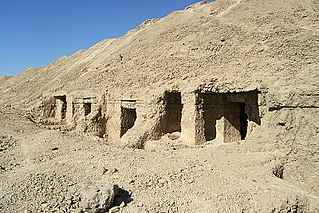
El Hawawish is the ancient necropolis (cemetery) for the city of Akhmim in the 9th Nome of Upper Egypt (UE09), in modern the Sohag Governorate, Egypt.

Minya is the capital of the Minya Governorate in Upper Egypt. It is located approximately 245 km (152 mi) south of Cairo on the western bank of the Nile River, which flows north through the city.
The necropolis of Meir is an archaeological site in Middle Egypt in the Asyut Governorate located on the west bank of the Nile. Here are the graves of the nomarchs, mayors and priests of Cusae from the ancient Egyptian Old and Middle Kingdom.
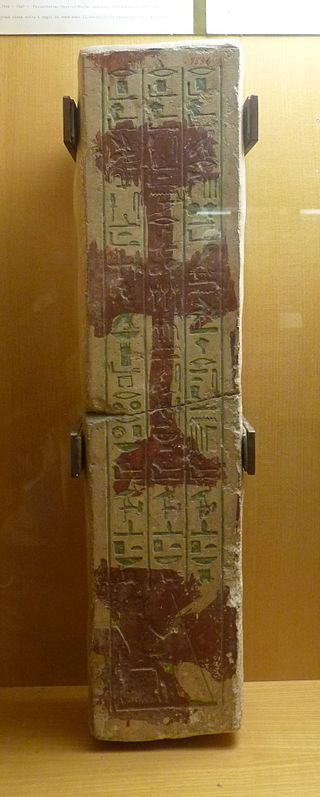
Djehutihotep was an ancient Egyptian nomarch of the fifteenth nomos of Upper Egypt during the twelfth dynasty, c. 1900 BC.
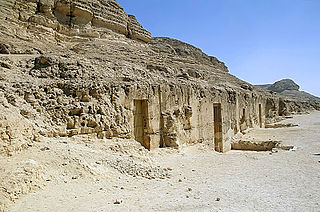
Baqet III was an ancient Egyptian official and Great Chief of the Oryx nome during the 11th Dynasty in the 21st century BCE. Apart from the position of governor of the entire nome, Baqet III also held the titles haty-a, treasurer of the king of Lower Egypt, confidential friend, true royal acquaintance, and mayor of Nekheb.
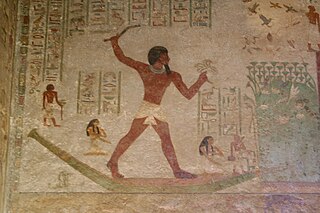
Khnumhotep II was an ancient Egyptian Great Chief of the Oryx nome during the reign of pharaohs Amenemhat II and Senusret II of the 12th Dynasty, Middle Kingdom. He is well known for his tomb at Beni Hasan and its decorations.

Khnumhotep I was an ancient Egyptian Great Chief of the Oryx nome during the reign of Pharaoh Amenemhat I of the 12th Dynasty, Middle Kingdom.
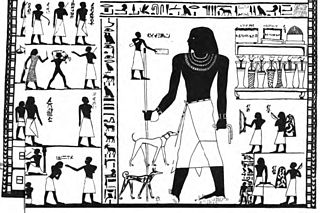
Amenemhat, often reported with his short form Ameny (Jmnjj), was an ancient Egyptian "Overlord of the Oryx nome" and chief priest during the reign of pharaoh Senusret I of the 12th Dynasty.

The Oryx nome was one of the 42 nomoi in ancient Egypt. The Oryx nome was the 16th nome of Upper Egypt, and was named after the scimitar oryx. It was located, approximately, in the territories surrounding the modern city of Minya in Middle Egypt.

The Hare nome, also called the Hermopolite nome was one of the 42 nomoi in ancient Egypt; more precisely, it was the 15th nome of Upper Egypt.

Kaikhenet was an ancient Egyptian local governor in the 10th Upper Egyptian province; the latter called Wadjet in Egyptian language. Kaikhenet lived at the beginning of the Fifth Dynasty and is known from his decorated rock cut tomb at Hemamieh. Decorated rock cut tombs are very rare in the Egyptian province before the end of the Fifth Dynasty. The tombs at Hemamieh are an exception. They belong to the earliest ones in the provinces.
Zatipy was an ancient Egyptian woman who lived around 2000 BC at the beginning of the 12th Dynasty under king Amenemhat I. She was the wife of Khnumhotep I who was local governor in the Oryx nome. Zatipy is depicted in the tomb of her husband at Beni Hasan. There she is shown behind him, both watching activities of peasants in the marshes. Behind her depiction, her name and titles are written. She was member of the elite (iryt-pat), wife of the ruler and lady of the house. She is also called mistress of all women. The relative high number of titles is remarkable. Especially the title member of the elite is rare for women and only better attested for women with royal connections. It was therefore proposed that Zatipy came from a royal or highly important family. If she was a princess, king Amenemhat I might have tried with this marriage to keep close ties to an important local family.
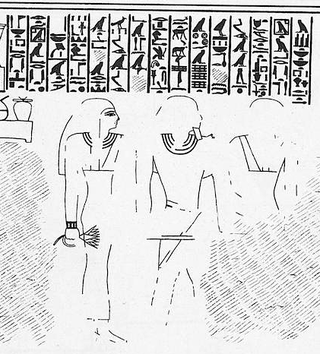
Netjernakht was an Ancient Egyptian official known from his tomb chapel at Beni Hasan in Middle Egypt. He lived most likely in the Twelfth Dynasty. His exact date and position are disputed.
Ramushenti was an ancient Egyptian local governor of the Oryx nome in Middle Egypt. He is only known from his decorated tomb chapel at Beni Hasan. In the decoration of his tomb chapel appear several inscriptions providing the name and titles of Ramushenti. He was great overlord of the Oryx nome. This is the main title of the local governors. Other titles include count (Haty-a), royal sealer, sole friend, king's acquaintance, who is in the chamber, who belongs to Nekhen and overlord of Nekheb,. Not much is known about his family. However, the parents of the local governor Baqet III are a person called Ramushenti and a woman called Heteperau. The two Ramushentis might be the same person. According to this, Ramushenti was the father of Baqet III who was most likely his successor.
Nakht was an ancient Egyptian local governor in Men'at Khufu in Middle Egypt in the Twelfth Dynasty. He is known from his decorated tomb chapel at Beni Hasan. The decoration of his tomb chapel is most likely unfinished. Only one wall is partly decorated with paintings, showing him standing in front of workers in the marshes. The inscriptions there provide the name and titles of Nakht. He was mayor and overseer of the eastern desert. Nakht is also mentioned in the tomb chapel of Khnumhotep II (BH3). In his chapel is a long biographical inscription reporting on the life of the governor but also on his family. There is stated that Khnumhotep I installed Nakht as governor in Men'at Khufu.















